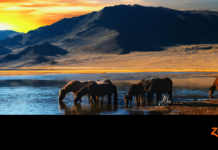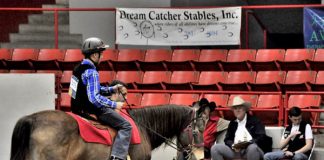
There are a few talented photographers who make their living selling photos of horses. Still, many people diversify in order to make a living, becoming “jacks-of-all-trades” and adding skills like writing, web design, videography and more to their repertoires. Some photographers sell directly to riders, some use their images for editorial or sell them to news agencies, equestrian equipment companies for advertising, or they may be employed by a specific brand.
Getting Started in the Business
Florida-based equine photographer Sue Stickle specializes in dressage and is the official show photographer for competitions like the Adequan Global Dressage Festival in Wellington, Fla. and has photographed multiple Olympic and World Equestrian Games competitions.
Stickle, who grew up in Maplewood, NJ and is now calls Florida home, says that she is totally self-taught. She started out photographing landscapes, but enjoyed the challenge of capturing horses at the optimum moment.
“I learned as I went,” she says. “I did a lot of my own studying through magazines and books. I don’t want to age myself, but there was no Internet when I was learning the ropes. It’s just something I’ve always been into, and I’d have people come up to us at shows and ask me to take their picture, and that’s when I thought I could make a business out of it.”
While she did not apprentice with another professional, Stickle says Susan Sexton and Terri Miller are two photographers that she has always looked up to. “Charlie Mann and Amy Dragoo are very creative and I love their work too,” she says.
Shannon Brinkman comes from an artistic background, and says she studied photography, art, and fine art to achieve her BFA in Graphic Design. In addition to horses she authored a book of photographs about Preservation Hall in New Orleans (LSU Press, 2011) from which 65 of her images are currently on display at the Mint Museum in New Orleans. Brinkman shoots primarily three-day eventing but as the official photographer for the US Equestrian Federation she covers all equestrian disciplines.
“I was lucky to grow up with film,” says Brinkman. “You had to get it right the first time, there weren’t second chances, so it developed your eye in a way that digital can’t. It helps you size up the whole image, not just the subject, rather fast.”
Brinkman says she is always trying to improve. “Even today I’m looking at my old pictures, my new pictures and other people’s pictures. I’m always on the hunt. I never stay still!”
Shoot What You Know
Stickle advises equestrians to stick to the sport they know. “I like dressage a lot, so I think that helps you shoot it better. I can go and shoot show jumping, for example, but being as I’ve never done it, I don’t understand it as fully as someone who’s ridden jumper courses. It gives you better perspective when you’ve ridden it yourself.”
Brinkman grew up riding, and her mom Jean and sister Erin still breed, train and ride horses in Florida. “They help critique my work so I can figure out the best pictures; I’ve also sat with Sue Stickle to better my dressage pictures, and at the last show I asked (Olympic dressage judge) Marilyn Payne to critique some photos. I keep on trying to better myself and it’s a heck of a lot of work.”
Challenges of the Internet Age
With every other parent/friend/boyfriend toting a digital camera these days, business is tough for show photographers. And since digital images can often be copied and shared online, it makes even tougher for photographers to make a living when consumers ignore copyright and don’t pay for images.
“A lot of times when people grab a photo and post it on Facebook they don’t realize it’s not allowed,” says Stickle. “Most of the time I contact them, tell them they can’t do it, and then we work something out. By and large it’s pretty innocent. Of course there are also people who try to grab a photo and get away with it.”
She advises, “If you find an image you like, call the photographer and ask if you can use it or if there’s a charge; sometimes it’s no problem, but some photographers might take you right to court! We try to give clients the benefit of the doubt when it comes to that.”
Financially, Brinkman pointed out that even though she has established a name for herself, it is still a struggle to make ends meet. “I have to diversify so much and I’ve been doing this for years. I still live in a shotgun shack in New Orleans; it doesn’t matter how famous you are, you have to keep working on it every day.”
If you aspire to be a professional photographer, Stickle recommends taking classes, or even trying to apprentice with a show photographer. “There’s a lot more to the business than what you see at shows,” she says. “Our days are filled with editing images, fulfilling orders and requests, not to mention buying and maintaining the equipment.”
 |
| Charlie Mann and Sue Stickle work in the rain at a horse show in Gladstone, N.J. Photo: Jonna Koelhoffer |
And let’s not forget that professional photographic equipment doesn’t come cheap. “At this point I’ve probably got upwards of $50,000 in camera equipment,” she says. “I didn’t start out with top of the line equipment, but as my knowledge and bank account grew it improved. There are plenty of “pro-sumer” quality cameras for a lot less money, I just don’t recommend using an iPhone!”
It’s Not Always Glamorous
Stickle also cautions that becoming a pro equine photographer is not the job for everyone. “We’ve been at shows in pouring rain from the time we arrived until we left, the expensive camera covers were soaked through down to the lenses – it’s not all fun and games,” she says. “Young Riders in July is always around 105 degrees on the ground. We can’t pick and choose when we want to arrive – we have to be there from the time it starts to the time it ends. It’s not as easy and certainly nowhere near as glamorous as people may think! Covering the Olympics and WEG are great, but you spend a lot of time on a bus to and from the venue.”
She summarizes, “Be prepared for hard work and a lot of it! There are easier jobs out there, but we wouldn’t be able to do it and be successful if we didn’t love it. I think that’s the bottom line.”
Liked this article? Here’s more info on equine photography.
Equine Photography Tips from the Pros
Horse Illustrated Photo Contest Winners






Great tips and advise, and a good article to read, just for taking your own pictures, like to sell a horse, or at local shows.
I love photography and I love horses and I love photographing horses. Thanks for the extra tips.
cool
Neat
Well I read the article and it is interesting. However, I did not see anything related to how to shoot equestrian photograhpy, i.e. dressage, show jumping, cross country. Perhaps that if forthcoming……………..thanks.